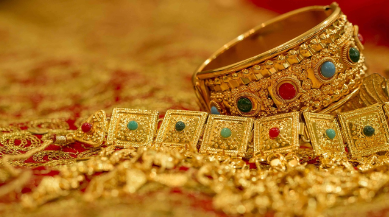
Gold has been used for centuries for everything, from being used as a symbol of wealth to currency, stabilizing economies, making circuits, creating dental pieces, and even adorning royals.
Many people prefer saving their hard-earned money in the form of gold coins, bullion, and jewelry. However, if you’re planning to take advantage of high current prices by converting the gold to cash, you need a reliable buyer. Online buyers tend to offer better prices for gold than when it’s sold through jewelry stores or pawn shops.
Whether you’re selling your engagement ring, wedding band, necklace, or other gold jewelry, contact us to get the best price while benefiting from a fast and friendly process that’s free of all hard-sell sales tactics. All you need to do is to apply for your free appraisal kit!
At Gold to Cash, we buy gold through offers based on established criteria that we’ve been following ever since the company was established about a decade ago. As the premier online gold buyer in the United States, we’re extremely transparent about how we assess your gold when you send it our way to get it appraised for free from our team of master gemologists.
But when it comes to buying or selling gold, knowing what each karat type means is crucial as it significantly impacts value. For example, one gold bracelet may be more expensive than the other, not because of its weight but rather because it’s made of a higher quality of gold.
While understanding gold purity levels can be a little confusing at first, our experts are here to make the process fairly easier while helping you become familiar with the basics so you can make informed decisions regarding your future.
Carat vs Karat: The Measure of Gold’s Purity
Gold’s purity is categorized using the karat scale. It measures the ratio of alloys to pure gold. The greater the amount of pure gold in a piece, the higher the purity level is. The portion which isn’t gold is typically a mixture of nickel, copper, silver, and other metals. These are referred to as alloys, with each one having its own characteristics in terms of malleability, brittleness, and color.
24k is the purest gold with 24 out of 24 parts of pure gold without the presence of any other metals. The next on the karat scale is 18k, 14k, and 10k, following the same standards. Although jewelers can create gold alloys in any amount of karat, 14k, 18k, 14k, and 19k are the most common ones because of their suitability and appearance. Moreover, each purity level comes with its own range of pros and cons.
Did You Know: Many people confuse gold karats with carats. The former refers to gold’s purity, whereas carats refer to gem’s weight.
24-Karat Gold
Pure gold, or 24k gold, has absolutely no alloy added. The bright yellow color is best for heirlooms and jewelry worn only on special occasions. This type of gold is very soft and bendable, so it’s used more commonly for building wealth in India, China, and other Asian countries. Pure gold also scratches more easily, so it can quickly become unattractive and scuffed.
18-Karat Gold
Made of 25% alloy and 75% gold, this type of gold is one of the most commonly used ones for watches, rings, and other wearable jewelry. The yellow and rich appearance makes it an attractive option because it is hypoallergenic and looks fabulous! It boasts the classic yellow appearance people often associate with gold jewelry.
However, since it’s pure, it’s usually softer than other karats, making it less ideal for active lifestyles or occupations requiring more hard work. It’s easy to scratch and significantly more expensive than other gold types.
14-Karat Gold
Made up of 14 out of 24 parts gold, 14-karat offers a great mix of durability, purity, and value for money. People in the UK, USA, and other Western countries prefer 14k gold for wearable jewelry for its classic appearance and rich color that is slightly less saturated than 18k gold.
14-k gold is ideal for daily wear as it doesn’t scuff or scratch easily and is more affordable. But since there’s a higher content of other metals, it can cause skin irritation for some with sensitive skin or allergies.
10-Karat Gold
Made of 58% alloy and 42% gold, 10-karat gold is one of the least expensive and least pure options but with more durability. For most countries, including the US, it’s the most impure gold can be while still being eligible to be called gold.
While many fine jewelry makers don’t offer 10-karat gold collections, it’s still very common in fancy accessories because of its affordability. Meanwhile, gold jewelry made of 10k gold has a subdued and faint yellow finish and can cause irritation in some cases due to the low gold content.
Pieces made from 10-karat gold are also safe from scuffing, scratching, or bending, making them a feasible option for those who work in harsh environments or those who want to wear their favorite pieces without damaging or scratching them.
Unsure about the type of gold you want to sell? Request an appraisal kit from Gold to Cash. We’re proud to be reputable, efficient, and trustworthy online gold buyers offering the best prices in town!
Our experienced gemologists know the significance of valuable heirlooms and gold bullion and coins you may have collected with your hard-earned money to secure your future. Instead of being lured by scammers and lowballers, read our reviews to learn what makes us the top-rated online gold and silver buyers in the United States.
By partnering with us, you can convert gold to cash within 24 hours from the time you accept our offer. Contact us now to sell your gold jewelry online with the peace of mind you deserve.